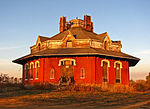Pickaway County Memorial Airport
Airports in OhioAviation in OhioBuildings and structures in Pickaway County, OhioTransportation in Pickaway County, Ohio
Pickaway County Memorial Airport (ICAO: KCYO, FAA LID: CYO) is a publicly-owned, public-use airport located 5 miles south of Circleville, Ohio. The airport sits on 61 acres at an elevation of 684 feet.The airport is home to a chapter of the Experimental Aircraft Association, which hosts a variety of events throughout the week and the year. The airport also hosts a regular airplane fly-in that features historic airplanes, such as a World War 2 era B-25 Mitchell bomber.
Excerpt from the Wikipedia article Pickaway County Memorial Airport (License: CC BY-SA 3.0, Authors).Pickaway County Memorial Airport
McCrady Road,
Geographical coordinates (GPS) Address External links Nearby Places Show on map
Geographical coordinates (GPS)
| Latitude | Longitude |
|---|---|
| N 39.516111111111 ° | E -82.982222222222 ° |
Address
Pickaway County Memorial Airport
McCrady Road 28181
Ohio, United States
Open on Google Maps







